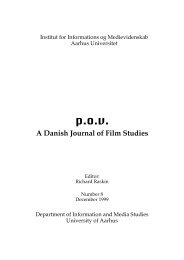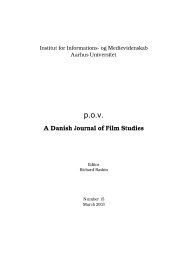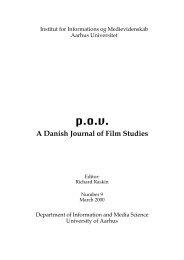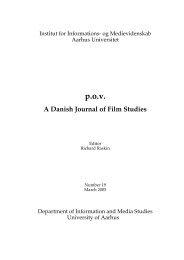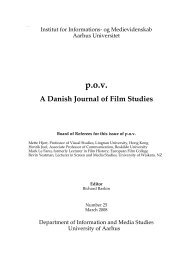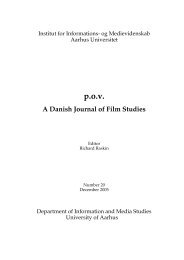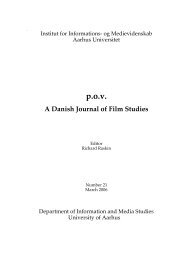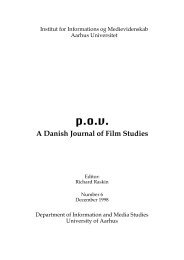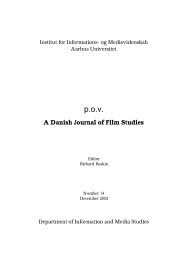The Face of Time - POV - Aarhus Universitet
The Face of Time - POV - Aarhus Universitet
The Face of Time - POV - Aarhus Universitet
You also want an ePaper? Increase the reach of your titles
YUMPU automatically turns print PDFs into web optimized ePapers that Google loves.
A Danish Journal <strong>of</strong> Film Studies 67<br />
was most probably the first time in his life that he was confronted<br />
with such a clear imperialistic stance in school. <strong>The</strong> waves may not<br />
have reached the Japanese countryside by the beginning <strong>of</strong> the<br />
1930s. <strong>The</strong> 1920s are known as the time when the ideas <strong>of</strong> free<br />
school had arrived and just settled in Japan (Fukaya 1996: 137-145).<br />
<strong>The</strong> turn to imperialism in the school curriculum was radical, but<br />
still it took time to take root all over the country.<br />
Imperialistic slogans started to be repeated and called out in a<br />
chorus every day before teaching started. <strong>The</strong> government had just<br />
managed to establish a fair amount <strong>of</strong> national schools. Until then it<br />
had depended on private schools to realize six years <strong>of</strong> compulsory<br />
education for every child. That was a great step forward toward the<br />
implementation <strong>of</strong> an imperialistic ideology in the teaching (Honda<br />
2000: 112-117). As my co-viewers see it, no child could have escaped<br />
from this machinery <strong>of</strong> propaganda.<br />
But the scenes <strong>of</strong> 1933 in Ohagi still show the comparatively s<strong>of</strong>t<br />
beginnings. Some years later the consequences <strong>of</strong> Tarô's answer to<br />
the teacher's question would have been much more severe, not only<br />
for himself, but most probably also for his parents for not educating<br />
their son in the right spirit.<br />
<strong>The</strong>re is one scene that left us all tense with fear and expectation<br />
for what might follow. It is the one where O-Yoshi <strong>of</strong>fers Tarô a<br />
kneeling cushion. To sit in the Japanese style as a form <strong>of</strong><br />
punishment should <strong>of</strong> course be done without any comfort. To give<br />
him a cushion is to challenge the teacher's order, and thus one<br />
expects consequences for both. But nothing happens, so we relax<br />
when the two start spinning tops, which in reality is another <strong>of</strong>fence<br />
to the teacher's authority.



